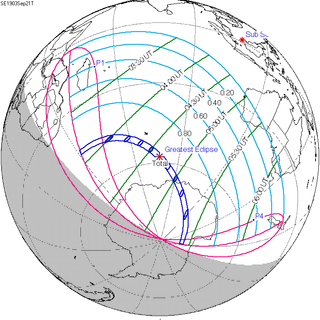Solar eclipse of September 21, 1903
| Solar eclipse of September 21, 1903 | |
|---|---|
| Type of eclipse | |
| Nature | Total |
| Gamma | −0.8967 |
| Magnitude | 1.0316 |
| Maximum eclipse | |
| Duration | 132 s (2 min 12 s) |
| Coordinates | 58°00′S77°12′E/ 58°S 77.2°E |
| Max. width of band | 241 km (150 mi) |
| Times (UTC) | |
| Greatest eclipse | 4:39:52 |
| References | |
| Saros | 123(47 of 70) |
| Catalog # (SE5000) | 9289 |
A totalsolar eclipseoccurred at the Moon'sascending nodeof orbit on Monday, September 21, 1903,[1][2][3]with amagnitudeof 1.0316. Asolar eclipseoccurs when theMoonpasses betweenEarthand theSun,thereby totally or partly obscuring the image of the Sun for a viewer on Earth. A total solar eclipse occurs when the Moon'sapparent diameteris larger than the Sun's, blocking all direct sunlight, turning day into darkness. Totality occurs in a narrow path across Earth's surface, with the partial solar eclipse visible over a surrounding region thousands of kilometres wide.
Related eclipses[edit]
Eclipses in 1903[edit]
- An annular solar eclipse on March 29, 1903.
- A partial lunar eclipse on April 12, 1903.
- A total solar eclipse on September 21, 1903.
- A partial lunar eclipse on October 6, 1903.
Metonic[edit]
- Preceded by:Solar eclipse of December 3, 1899
- Followed by:Solar eclipse of July 10, 1907
Tzolkinex[edit]
- Preceded by:Solar eclipse of August 9, 1896
- Followed by:Solar eclipse of November 2, 1910
Half-Saros[edit]
- Preceded by:Lunar eclipse of September 15, 1894
- Followed by:Lunar eclipse of September 26, 1912
Tritos[edit]
- Preceded by:Solar eclipse of October 20, 1892
- Followed by:Solar eclipse of August 21, 1914
Solar Saros 123[edit]
- Preceded by:Solar eclipse of September 8, 1885
- Followed by:Solar eclipse of October 1, 1921
Inex[edit]
- Preceded by:Solar eclipse of October 10, 1874
- Followed by:Solar eclipse of August 31, 1932
Triad[edit]
- Preceded by:Solar eclipse of November 19, 1816
- Followed by:Solar eclipse of July 22, 1990
Solar eclipses of 1902–1907[edit]
This eclipse is a member of asemester series.An eclipse in a semester series of solar eclipses repeats approximately every 177 days and 4 hours (a semester) at alternatingnodesof the Moon's orbit.[4]
| Solar eclipseseries sets from 1902 to 1907 | ||||
|---|---|---|---|---|
| Descending node | Ascending node | |||
| 108 | April 8, 1902 Partial |
113 | October 1, 1902 | |
| 118 | March 29, 1903 Annular |
123 | September 21, 1903 Total | |
| 128 | March 17, 1904 Annular |
133 | September 9, 1904 Total | |
| 138 | March 6, 1905 Annular |
143 | August 30, 1905 Total | |
| 148 | February 23, 1906 Partial |
153 | August 20, 1906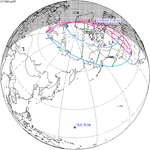 Partial | |
Saros 123[edit]
It is a part ofSaros cycle 123,repeating every 18 years, 11 days, containing 70 events. The series started with a partial solar eclipse on April 29, 1074. It contains annular eclipses from July 2, 1182 through April 19, 1651, hybrid eclipses from April 30, 1669 through May 22, 1705, and total eclipses from June 3, 1723 throughOctober 23, 1957.The series ends at member 70 as a partial eclipse on May 31, 2318. The longest duration of totality was 3 minutes, 27 seconds on July 27, 1813.
| Series members 47–63 occur between 1900 and 2200: | ||
|---|---|---|
| 47 | 48 | 49 |
 September 21, 1903 |
 October 1, 1921 |
 October 12, 1939 |
| 50 | 51 | 52 |
 October 23, 1957 |
 November 3, 1975 |
 November 13, 1993 |
| 53 | 54 | 55 |
 November 25, 2011 |
 December 5, 2029 |
 December 16, 2047 |
| 56 | 57 | 58 |
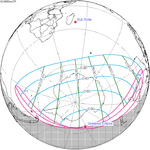 December 27, 2065 |
 January 7, 2084 |
 January 19, 2102 |
| 59 | 60 | 61 |
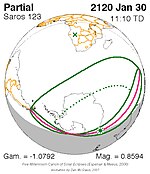 January 30, 2120 |
 February 9, 2138 |
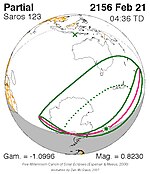 February 21, 2156 |
| 62 | 63 | |
 March 3, 2174 |
 March 13, 2192 | |
Inex series[edit]
This eclipse is a part of the long periodinexcycle, repeating at alternating nodes, every 358synodic months(≈ 10,571.95 days, or 29 years minus 20 days). Their appearance and longitude are irregular due to a lack of synchronization with theanomalistic month(period of perigee). However, groupings of 3 inex cycles (≈ 87 years minus 2 months) comes close (≈ 1,151.02 anomalistic months), so eclipses are similar in these groupings.
In the 19th century:
- Solar Saros 120: Total Solar Eclipse of 1816 Nov 19
- Solar Saros 121: Hybrid Solar Eclipse of 1845 Oct 30
- Solar Saros 122: Annular Solar Eclipse of 1874 Oct 10
| Inex series members between 1901 and 2100: | ||
|---|---|---|
 September 21, 1903 (Saros 123) |
 August 31, 1932 (Saros 124) |
 August 11, 1961 (Saros 125) |
 July 22, 1990 (Saros 126) |
 July 2, 2019 (Saros 127) |
 June 11, 2048 (Saros 128) |
 May 22, 2077 (Saros 129) |
||
In the 22nd century:
- Solar Saros 130: Total Solar Eclipse of 2106 May 3
- Solar Saros 131: Annular Solar Eclipse of 2135 Apr 13
- Solar Saros 132: Hybrid Solar Eclipse of 2164 Mar 23
- Solar Saros 133: Total Solar Eclipse of 2193 Mar 03
Tritos series[edit]
This eclipse is a part of atritoscycle, repeating at alternating nodes every 135synodic months(≈ 3986.63 days, or 11 years minus 1 month). Their appearance and longitude are irregular due to a lack of synchronization with theanomalistic month(period of perigee), but groupings of 3 tritos cycles (≈ 33 years minus 3 months) come close (≈ 434.044 anomalistic months), so eclipses are similar in these groupings.
| Series members between 1901 and 2100 | |||
|---|---|---|---|
 September 21, 1903 (Saros 123) |
 August 21, 1914 (Saros 124) |
 July 20, 1925 (Saros 125) | |
 June 19, 1936 (Saros 126) |
 May 20, 1947 (Saros 127) |
 April 19, 1958 (Saros 128) | |
 March 18, 1969 (Saros 129) |
 February 16, 1980 (Saros 130) |
 January 15, 1991 (Saros 131) | |
 December 14, 2001 (Saros 132) |
 November 13, 2012 (Saros 133) |
 October 14, 2023 (Saros 134) | |
 September 12, 2034 (Saros 135) |
 August 12, 2045 (Saros 136) |
 July 12, 2056 (Saros 137) | |
 June 11, 2067 (Saros 138) |
 May 11, 2078 (Saros 139) |
 April 10, 2089 (Saros 140) | |
 March 10, 2100 (Saros 141) |
|||
Notes[edit]
- ^"Total eclipse of the sun".Coventry Evening Telegraph.Coventry, West Midlands, England. 1903-09-21. p. 2.Retrieved2023-10-27– via Newspapers.com.
- ^"Page 4".The Evening Star.Dunedin, Otago, New Zealand. 1903-09-21. p. 4.Retrieved2023-10-27– via Newspapers.com.
- ^"Yesterday".Bruce Herald.Milton, Otago, New Zealand. 1903-09-22. p. 4.Retrieved2023-10-27– via Newspapers.com.
- ^van Gent, R.H."Solar- and Lunar-Eclipse Predictions from Antiquity to the Present".A Catalogue of Eclipse Cycles.Utrecht University.Retrieved6 October2018.
References[edit]
- Earth visibility chart and eclipse statisticsEclipse Predictions byFred Espenak,NASA/GSFC

